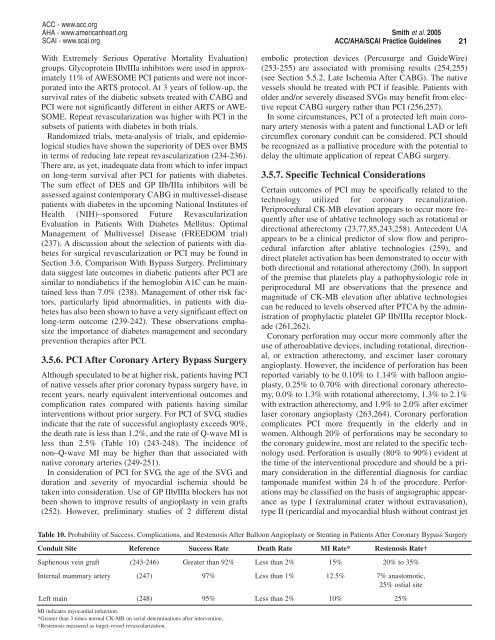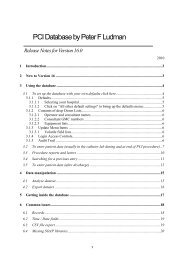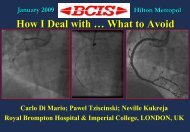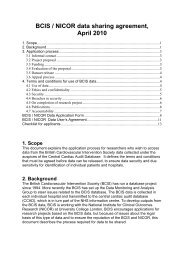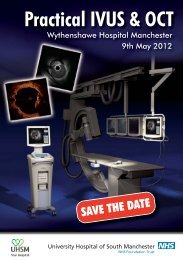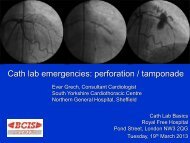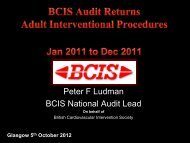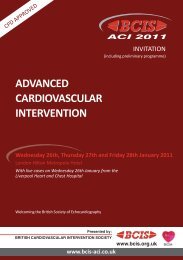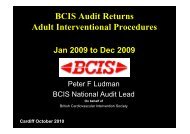Recommendations
ACC/AHA/SCAI PCI Guidelines - British Cardiovascular Intervention ...
ACC/AHA/SCAI PCI Guidelines - British Cardiovascular Intervention ...
- No tags were found...
You also want an ePaper? Increase the reach of your titles
YUMPU automatically turns print PDFs into web optimized ePapers that Google loves.
ACC - www.acc.org<br />
AHA - www.americanheart.org<br />
SCAI - www.scai.org<br />
Smith et al. 2005<br />
ACC/AHA/SCAI Practice Guidelines<br />
21<br />
With Extremely Serious Operative Mortality Evaluation)<br />
groups. Glycoprotein IIb/IIIa inhibitors were used in approximately<br />
11% of AWESOME PCI patients and were not incorporated<br />
into the ARTS protocol. At 3 years of follow-up, the<br />
survival rates of the diabetic subsets treated with CABG and<br />
PCI were not significantly different in either ARTS or AWE-<br />
SOME. Repeat revascularization was higher with PCI in the<br />
subsets of patients with diabetes in both trials.<br />
Randomized trials, meta-analysis of trials, and epidemiological<br />
studies have shown the superiority of DES over BMS<br />
in terms of reducing late repeat revascularization (234-236).<br />
There are, as yet, inadequate data from which to infer impact<br />
on long-term survival after PCI for patients with diabetes.<br />
The sum effect of DES and GP IIb/IIIa inhibitors will be<br />
assessed against contemporary CABG in multivessel-disease<br />
patients with diabetes in the upcoming National Institutes of<br />
Health (NIH)–sponsored Future Revascularization<br />
Evaluation in Patients With Diabetes Mellitus: Optimal<br />
Management of Multivessel Disease (FREEDOM trial)<br />
(237). A discussion about the selection of patients with diabetes<br />
for surgical revascularization or PCI may be found in<br />
Section 3.6, Comparison With Bypass Surgery. Preliminary<br />
data suggest late outcomes in diabetic patients after PCI are<br />
similar to nondiabetics if the hemoglobin A1C can be maintained<br />
less than 7.0% (238). Management of other risk factors,<br />
particularly lipid abnormalities, in patients with diabetes<br />
has also been shown to have a very significant effect on<br />
long-term outcome (239-242). These observations emphasize<br />
the importance of diabetes management and secondary<br />
prevention therapies after PCI.<br />
3.5.6. PCI After Coronary Artery Bypass Surgery<br />
Although speculated to be at higher risk, patients having PCI<br />
of native vessels after prior coronary bypass surgery have, in<br />
recent years, nearly equivalent interventional outcomes and<br />
complication rates compared with patients having similar<br />
interventions without prior surgery. For PCI of SVG, studies<br />
indicate that the rate of successful angioplasty exceeds 90%,<br />
the death rate is less than 1.2%, and the rate of Q-wave MI is<br />
less than 2.5% (Table 10) (243-248). The incidence of<br />
non–Q-wave MI may be higher than that associated with<br />
native coronary arteries (249-251).<br />
In consideration of PCI for SVG, the age of the SVG and<br />
duration and severity of myocardial ischemia should be<br />
taken into consideration. Use of GP IIb/IIIa blockers has not<br />
been shown to improve results of angioplasty in vein grafts<br />
(252). However, preliminary studies of 2 different distal<br />
embolic protection devices (Percusurge and GuideWire)<br />
(253-255) are associated with promising results (254,255)<br />
(see Section 5.5.2, Late Ischemia After CABG). The native<br />
vessels should be treated with PCI if feasible. Patients with<br />
older and/or severely diseased SVGs may benefit from elective<br />
repeat CABG surgery rather than PCI (256,257).<br />
In some circumstances, PCI of a protected left main coronary<br />
artery stenosis with a patent and functional LAD or left<br />
circumflex coronary conduit can be considered. PCI should<br />
be recognized as a palliative procedure with the potential to<br />
delay the ultimate application of repeat CABG surgery.<br />
3.5.7. Specific Technical Considerations<br />
Certain outcomes of PCI may be specifically related to the<br />
technology utilized for coronary recanalization.<br />
Periprocedural CK-MB elevation appears to occur more frequently<br />
after use of ablative technology such as rotational or<br />
directional atherectomy (23,77,85,243,258). Antecedent UA<br />
appears to be a clinical predictor of slow flow and periprocedural<br />
infarction after ablative technologies (259), and<br />
direct platelet activation has been demonstrated to occur with<br />
both directional and rotational atherectomy (260). In support<br />
of the premise that platelets play a pathophysiologic role in<br />
periprocedural MI are observations that the presence and<br />
magnitude of CK-MB elevation after ablative technologies<br />
can be reduced to levels observed after PTCA by the administration<br />
of prophylactic platelet GP IIb/IIIa receptor blockade<br />
(261,262).<br />
Coronary perforation may occur more commonly after the<br />
use of atheroablative devices, including rotational, directional,<br />
or extraction atherectomy, and excimer laser coronary<br />
angioplasty. However, the incidence of perforation has been<br />
reported variably to be 0.10% to 1.14% with balloon angioplasty,<br />
0.25% to 0.70% with directional coronary atherectomy,<br />
0.0% to 1.3% with rotational atherectomy, 1.3% to 2.1%<br />
with extraction atherectomy, and 1.9% to 2.0% after excimer<br />
laser coronary angioplasty (263,264). Coronary perforation<br />
complicates PCI more frequently in the elderly and in<br />
women. Although 20% of perforations may be secondary to<br />
the coronary guidewire, most are related to the specific technology<br />
used. Perforation is usually (80% to 90%) evident at<br />
the time of the interventional procedure and should be a primary<br />
consideration in the differential diagnosis for cardiac<br />
tamponade manifest within 24 h of the procedure. Perforations<br />
may be classified on the basis of angiographic appearance<br />
as type I (extraluminal crater without extravasation),<br />
type II (pericardial and myocardial blush without contrast jet<br />
Table 10. Probability of Success, Complications, and Restenosis After Balloon Angioplasty or Stenting in Patients After Coronary Bypass Surgery<br />
Conduit Site Reference Success Rate Death Rate MI Rate* Restenosis Rate†<br />
Saphenous vein graft (243-246) Greater than 92% Less than 2% 15% 20% to 35%<br />
Internal mammary artery (247) 97% Less than 1% 12.5% 7% anastomotic,<br />
25% ostial site<br />
Left main (248) 95% Less than 2% 10% 25%<br />
MI indicates myocardial infarction.<br />
*Greater than 3 times normal CK-MB on serial determinations after intervention..<br />
†Restenosis measured as target-vessel revascularization.


